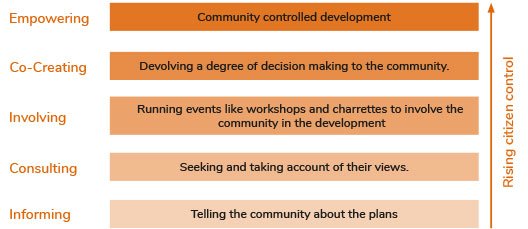Influence
At the scale of the neighbourhood, a sense of control can be achieved through community, tenants’ and residents’ groups, local councillors, neighbourhood watch groups, parish councils, community land trusts, neighbourhood plan groups and civic societies.
It can also include civil society groups such as churches and other places of worship, youth clubs, schools, sports clubs and allotment societies – any organisation that allows local communities to work together to improve the quality of our area and address local problems.
Research for the Quality of Life Foundation by Social Life and Kaizen Partnership has found that it is primarily through our local communities that we experience our quality of life. Furthermore, community ties strengthened during lockdown, as we got to know more of our neighbours and worked together to set up local support groups. There is real potential to build on these community links post lockdown.
Control and the neighbourhood
Neighbourhood engagement can take many forms. It is common for community groups to be consulted on issues such as policing, planning and other local government functions.
Sometimes these groups are given a degree of delegated decision-making or a local discretionary budget. This can be expanded into participatory budgeting, where a proportion of the council’s budget is allocated by the community either through voting or a community council.
Community groups can also own or manage property. The 2011 Localism Act gives communities the right to bid to run local services and to take over empty public buildings. The Localism Act also allows communities to create their own Neighbourhood Plans that can be adopted as part of the planning system.
In some neighbourhoods, communities have taken on functions like looking after public spaces, using maintenance budgets and employing a local workforce. Communities can also own and run local energy companies generating renewable power and selling it to local people. They can even become developers, creating housing and workspace. All of these activities are linked to increased feelings of wellbeing locally.
Control and development
It is particularly important to involve local communities when development and other physical works are planned. It is disheartening that research highlighted in the literature review suggests that residents who have recently been involved in consultation are the least likely to trust developers.
In 1969 Sherry Arnstein suggested a ladder of engagement to represent levels of community engagement which can apply to planning and many activities. The original ladder had eight rungs and ranged from ‘manipulation’ to ‘citizen control’. Over the years it has been modified and the version below is the most commonly used.
The level of engagement will depend on what is planned and how it affects the community in question. People living near to a proposal should, at the very least, expect to be ‘consulted’ or ‘involved’. On the other hand, where communities are directly affected, such as the redevelopment of their estates or low traffic neighbourhoods, the community should be treated as clients through ‘involvement’, ‘co-creation’ and ‘empowerment’.

What you can do
Communities
A good start is to review or audit all of the activity already taking place locally, which is often more than you would think. Bringing these groups together for a structured visioning event can be useful in setting priorities and opening-up a dialogue with the local authority. This can lead to initial activities like litter picks or street parties. There are often small grants available from the council to fund these activities, which can be accessed through local councillors or neighbourhood officers. As confidence, trust and participation grows, more ambitious initiatives can be taken on – who knows where it will take you.
Developers and designers
Treat community engagement seriously. Develop a strategy at the outset to identify which communities will be affected by the development and the appropriate level of engagement. Organise workshops and charrettes where there can be a real dialogue with local people rather than just exhibitions and drop-in events.
Councils
Devote staff time and resources to supporting local communities in every ward. A network of community development officers with a small budget can support a wide range of community activities that will help to reduce pressure elsewhere in the council. Consider neighbourhood committees (if they don’t already exist) and explore what decisions and spending can be delegated to them.
Case study
Control: Old Trafford, Manchester
Commissioned in 2008, the Old Trafford masterplan sought to address the poor physical layout and wider integration of the area, while ensuring that the existing settled community were involved in the redevelopment process and were not displaced from their homes.
Contact
Send us a message
Contact